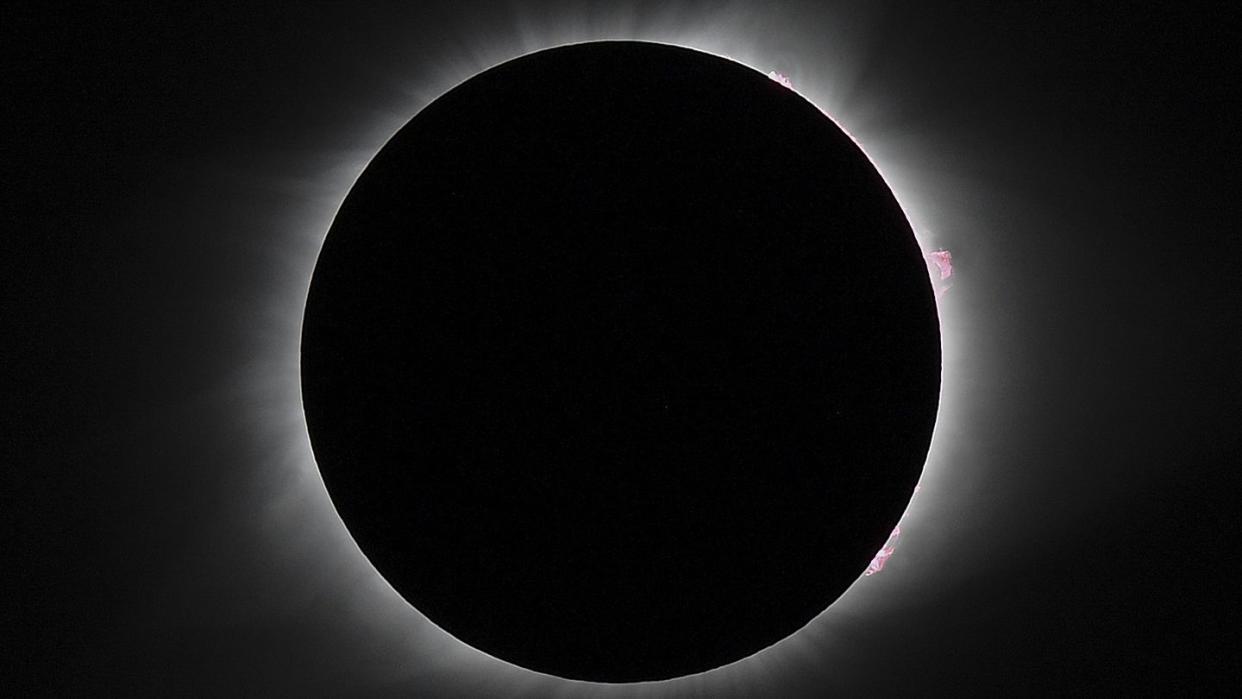Here Is the Path of Totality for the Solar Eclipse

The April 8 total solar eclipse path of totality touches 13 American states and hits some major U.S. cities along the way.
An estimated 32 million people live within the U.S. section of the path of totality.
Texan cities San Antonio, Austin, Dallas, and Fort Worth are all in the path at one of the longest-lasting times of the eclipse.
Even a total solar eclipse is bigger in Texas.
To eke out every possible second of the April 8 total solar eclipse, you’ll need to head to the center of the path of totality and do so at the height of the eclipse’s longevity. In the U.S., that spot is the Hill Country of Texas, northwest of San Antonio. The towns of Kerrville and Fredericksburg will serve as the epicenter for the eclipse, each offering up a whopping 4 minutes, 25 seconds of eclipse action in a place known for clear skies.
It’s a path of totality dream.
What Is the Path of Totality?
A solar eclipse path of totality is the stretch where the Moon slides between the Sun and Earth and blocks the Sun 100 percent. The closer a viewer is to the center line of the path, the longer the eclipse lasts. For April 8, that 115-mile-wide path touches 500 U.S. cities and portions of 13 states during daylight hours, covering major metropolitan areas such as San Antonio, Austin, Dallas, Fort Worth, Indianapolis, Cleveland, Buffalo, Rochester, and Syracuse along the way.
“It will likely be the most-viewed astronomical event in American history,” Michael Zeiler, eclipse cartographer and co-founder of Great American Eclipse, said in a statement. “When you combine the populations of Mexico, U.S.A., and Canada that live inside the path of totality, and add all of those who will travel on eclipse day, a total of 50 million North Americans witnessing totality is possible.”
That allure will bring people from across the country—and potentially the world—to join the 32 million people already estimated to live within the path and witness the event.
The Eclipse Starts in Mexico
The total solar eclipse doesn’t begin (or end) in the United States—it just dominates the American afternoon. The total eclipse will first hit mainland North America near Mazatlán, Mexico, giving us our first glimpse of a total solar eclipse in a major city along the path. Near the height of the duration, the eclipse is expected to last 4 minutes, 20 seconds near Mazatlán.
The Eclipse is Bigger in Texas
The hot spot for the total solar eclipse is Texas. With expectations—and history—of clear skies during April and plenty of viewing locations, the areas outside of San Antonio and Austin are the prime locations to witness the eclipse. Add in that the eclipse will last a whopping 4 minutes, 25 seconds in both Kerrville and Fredericksburg, and it’s no wonder that these locations are expected to draw the most intense eclipse fans from across the country. Totality will occur in the area at 1:32 p.m. Central time.
Of course, having portions of four major Texas cities locked in the path of totality means that millions of people already living there needn’t do much to witness the event. Zeiler expects Texas to receive over one million visitors—Space.com predicts 1.5 million visitors—and Kerrville alone could welcome nearly half a million people coming to witness the height of the moment.
“People will realize that they can go from zero totality to four minutes totality just by driving an hour on Interstate 10,” Kim Arvidsson, associate professor pf physics at Schreiner University told Space.com. “There’s going to be a vast increase in traffic that day.”
The Heart of the South and Midwest
Upon leaving Texas, the eclipse runs through Oklahoma, Arkansas, Missouri, Kentucky, Illinois, Indiana, Ohio, and Pennsylvania. And it will hit some key cities along the way, including Indianapolis, Cleveland, and Akron. And by slipping near to St. Louis, Cincinnati, Detroit, and Pittsburgh, expect plenty of folks from those cities finding a spot in the path to view the afternoon event.
Indianapolis will have the eclipse for a strong 3 minutes and 51 seconds, and Cleveland just one second less. Zeiler believes the Midwest will attract the next greatest group of travelers, with Ohio and Indiana both welcoming about half a million people.
Eclipse Leaves U.S. After Northeast Stop
New York, Vermont, New Hampshire, and Maine round out the list of U.S. states along the path, adding Buffalo, Rochester, and Syracuse to the list of major cities under darkness. Of course, having New York City, Boston, Washington, D.C., and Philadelphia all within 200 miles of the path, expect the Northeast to host a whirlwind of interest. The eclipse departs Maine—and the United States—around 3:32 p.m. Eastern time.
Montreal Gets in on the Eclipse
It may be nearing the end of the path, but Montreal is in the path of totality—and Toronto and Ottawa aren’t that far off. Expect Canadians to flock toward Montreal for best viewing in Canada, although those in the maritime provinces will also be treated to the path before it hits the Atlantic Ocean.
You Might Also Like
